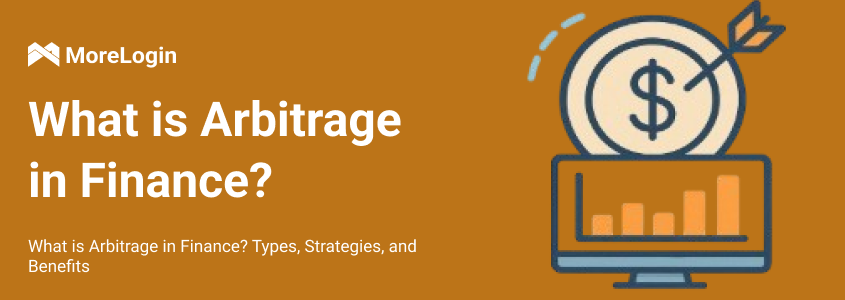
- Product

- Pricing
- Affiliate Program
- Use Cases
- Resource


Arbitrage is a fundamental concept in financial markets, offering investors and institutions a strategy to profit from price differences in different markets. Whether in stocks, foreign exchange, or commodities, arbitrage can be a low-risk way to generate consistent returns — if executed correctly. But what is arbitrage in finance, and how can it be used effectively?
This article explores the definition, types, benefits, and strategies of arbitrage in finance
At its core, arbitrage in finance is the practice of buying and selling the same or similar financial assets in different markets to profit from price differences. These price discrepancies might exist due to factors such as time delays, market inefficiencies, or currency fluctuations.
The principle behind arbitrage is simple. You buy low in one market, sell high in another, and pocket the difference, ideally with minimal risk.
Three key elements define what an arbitrage is in finance:
Price Discrepancy: The asset is priced differently across markets.
Simultaneous Transactions: Buying and selling occur almost instantly to avoid exposure to price movement.
Low Transaction Costs: Profits must exceed trading fees or costs for the arbitrage to be worthwhile.
Although arbitrage is often associated with large financial institutions, retail investors can also explore arbitrage strategies, especially with the support of modern trading tools.
Arbitrage in finance exists in many forms, depending on the assets and markets involved. Here are some of the most common types:
Spatial Arbitrage: Buying and selling the same asset on different exchanges, such as arbitrage Ethereum prices between Kraken and Huobi.
Temporal Arbitrage: Exploiting price differences over time, especially during market lags or delayed price reactions.
Currency Arbitrage: Taking advantage of discrepancies in currency exchange rates between different forex markets.
Triangular Arbitrage: A more complex strategy using three currencies to exploit rate mismatches.
Statistical Arbitrage: Uses mathematical models and algorithms to identify mispriced assets with the expectation that they will revert to their mean.
Merger Arbitrage: Investors bet on the outcome of mergers or acquisitions by trading the stocks of the involved companies.
Regulatory Arbitrage: Profiting from differences in regulations or tax treatments in various regions.

After understanding the types of arbitrage, we need to know why we choose to do arbitrage in Finance. Here are several compelling advantages:
When executed correctly, arbitrage involves minimal market risk because positions are opened and closed almost simultaneously. There’s no need to hold onto an asset for long, reducing exposure to volatility.
Arbitrage plays an essential role in enhancing market efficiency. When traders exploit pricing differences, it encourages markets to correct mispricings quickly, leading to fairer pricing for all participants.
Arbitrage enables diversification by moving beyond traditional long/short approaches, incorporating strategies such as cross-market arbitrage, cross-asset arbitrage, and cross-geographic arbitrage.
With the rise of digital assets and 24/7 markets, arbitrage isn’t confined to local exchanges. Traders can take advantage of price gaps across global markets. For example, buying an asset at a lower price on one regional exchange while simultaneously selling it at a higher price on another, such as equities listed in dual markets.
Understanding these advantages provides the foundation. Next, we turn to how arbitrage strategies are designed and executed in practice.

Modern arbitrage strategies often rely on algorithmic trading and real-time data feeds. These systems scan multiple markets for opportunities and execute trades within milliseconds. Speed is critical — arbitrage windows often close within seconds.
This is where tools like MoreLogin come into play.
MoreLogin is a multi-account browser that helps traders manage multiple identities, sessions, and trading environments — all from one dashboard. In arbitrage scenarios, it provides:
Isolated browser environments to operate across different exchanges without triggering anti-bot detection.
Geo-location customization makes it easier to access international platforms with region-locked content or pricing.
Efficient session management to avoid repeated logins, saving time during high-speed trading events.
Learn more about how MoreLogin supports arbitrage execution in this article: Arbitrage Creatives by MoreLogin.
Arbitrage is often described as low risk, but it is not completely free of danger. Traders face execution risk when prices change before the trades are completed. Liquidity risk appears if there is not enough trading volume, making it hard to buy or sell at the desired price. Transaction costs such as fees and funding charges can quickly reduce profits. Regulatory risk may also arise when trading across different markets with varying legal rules.
A classic case of arbitrage involves Bitcoin. Suppose Bitcoin is trading at $30,000 on Exchange A and $30,300 on Exchange B. A trader could purchase 1 BTC from Exchange A and simultaneously sell it on Exchange B, thereby locking in a $300 profit, excluding transaction costs and fees.
This example illustrates a cross-exchange arbitrage opportunity, showing how traders profit from small price differences in volatile markets.
So, what is arbitrage in finance? It's a time-tested strategy to exploit price differences across markets, offering a path to consistent, low-risk profits. Whether in the form of currency arbitrage, statistical strategies, or crypto trades, arbitrage is a vital tool for traders at all levels.
From simple cross-market trades to algorithmic executions, arbitrage continues to evolve. Tools like MoreLogin make it easier for individual traders and institutions to monitor opportunities, manage multiple environments, and enhance arbitrage efficiency.